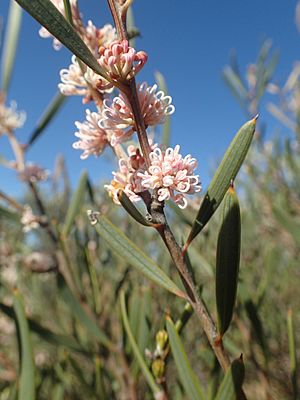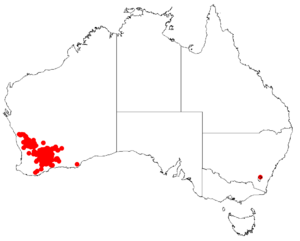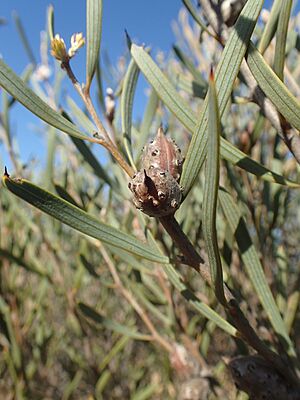Hakea erecta facts for kids
Quick facts for kids Hakea erecta |
|
|---|---|
 |
|
| Hakea erecta growing near Wongan Hills | |
| Scientific classification | |
| Genus: |
Hakea
|
| Species: |
erecta
|
 |
|
| Occurrence data from AVH | |
The Hakea erecta is a special type of shrub. It belongs to the Proteaceae plant family. This plant grows only in Western Australia, which means it is endemic to that area. It is a dense, rounded shrub with unique twisted leaves. It also has beautiful, sweet-smelling flowers. These flowers, which can be pink or white, bloom in spring. You can find up to 24 flowers growing together where the leaves meet the stem.
Contents
About the Hakea Erecta Plant
The Hakea erecta is a rounded shrub that does not have a special woody base called a lignotuber. It usually grows to be about 0.5 to 2.6 meters (1.6 to 8.5 feet) tall. This plant has many branches that spread out. Its bark is smooth and grey.
Leaves and Flowers
The younger branches have silky, flat hairs when the plant is flowering. The leaves can be either smooth or hairy. They are typically 4 to 10 centimeters (1.6 to 3.9 inches) long and 2.5 to 5 millimeters (0.10 to 0.20 inches) wide. The leaves are linear, flat, and twisted at their base. They end in a sharp point. Each leaf has a clear central vein and three veins on its underside.
The plant produces a single group of 16 to 24 flowers. These flowers are pink-cream in color and smell sweet. They grow in clusters where the leaves join the stem, mostly on the upper branches. The flower parts (called the perianth) are pink or white. The small stalks that hold the flowers (pedicels) are pink and smooth. The style, which is part of the flower's reproductive system, is 6.5 to 8 millimeters (0.26 to 0.31 inches) long.
Flowering Time and Fruit
Hakea erecta flowers from September to October. After flowering, it produces oblong or egg-shaped fruits. These fruits have a smooth surface, but they might have a few small bumps. Each fruit ends with a small pointed beak.
How it Got its Name
This type of hakea was first officially described in 1987. It was named by a scientist named Byron Lamont. He found a sample of the plant near Pingrup. The description was then published in a science journal called the Botanical Journal of the Linnean Society.
Meaning of the Name
The second part of its scientific name, erecta, comes from a Latin word. It means "upright." This name refers to how the plant's stems, leaves, and fruits tend to grow mostly straight up.
Where the Hakea Erecta Grows
The Hakea erecta plant is found only in certain parts of Western Australia. These areas include the Mid West, Wheatbelt, Great Southern, and Goldfields-Esperance regions.
It typically grows in scrubland and low woodland areas. You can often find it in deep sandy soils, especially where there is also a type of soil called laterite.
Conservation Status
The Western Australian Government's Department of Parks and Wildlife has classified Hakea erecta as "not threatened." This means the plant is not currently at risk of disappearing.
Using Hakea Erecta in Gardens
Hakea erecta is a great plant for gardens. It can handle frost well and blooms for a long time. It is a medium-sized shrub with attractive, scented flowers.
This plant is very adaptable. It can grow into dense, thick patches. These thickets provide a good home for local wildlife. They also work well as a low windbreak in gardens or on farms.


